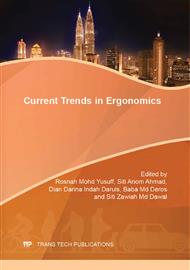[1]
KarimAbd H., Zarir Hafiz Z., Ilhamah O., Rohayu S., S.V. Wong, Radin Umar R.S., Kodamalan – KeselamatanKesihatandanPersekitaranuntuksektorpengangkutan, MCP 1/2007, Kuala Lumpur : Malaysian Institute of Road Safety Research. (2007).
Google Scholar
[2]
Albertsson, P., Falkmer, T. , Is there a pattern in European bus and coach incidents? A literature analysis with special focus on injury causation and injury mechanism. Accident Analysis and Prevention, Vol. 37, 225-233. (2005).
DOI: 10.1016/j.aap.2004.03.006
Google Scholar
[1]
RMP Statistical Report of Road Accidents Malaysia 2008. Royal Malaysia Police, Traffic Branch, Bukit Aman, Kuala Lumpur. (2009).
Google Scholar
[3]
Kirk, A., Grant, R., Bird, R., Bus and Coach Passenger Casualties in Non-CollisionIncidents. Ed. V.S.R.C.I. Ergonomics, Loughborough University. (2001).
Google Scholar
[4]
Langwieder, K., Danner, M., Hummel, T., Collision type and characteristics of bus accidents – their consequences for the bus passengers and the accident opponent. 10th International Technical Conference on Experimental Safety Vehicles (ESV), July (1985).
Google Scholar
[5]
ECE Regulation No. 36, Agreement (20 February 2008), United Nations, E/ECE/TRANS/505, Rev. 1/Add. 35/Rev 3.
Google Scholar
[6]
Petzäll, J., (Paper I) Mobility impaired people using public transport- guidelines for vehicle design. Design for accessibility: The development of public transport vehicles with regard to mobility impaired passengers. ISBN 91-7032-847-1. (1993).
Google Scholar
[7]
Matolcsy, M. (2003) Severity of bus rollover accidents. Paper Number 07-0989, ScientificSociety of Mechanical Engineers, Hungary.
Google Scholar
[8]
Matolcsy, Mátyás, New Requirements to the Emergency Exits Of Buses, Paper Number 09-0181, (2010).
Google Scholar
[9]
J.A. Levis, The seated bus passenger – A review, Applied Ergonomics, 1978, 9. 3, 143-150(1978).
DOI: 10.1016/0003-6870(78)90004-2
Google Scholar
[10]
Ahmad Noor Syukri Z. A, Siti Atiqah M.F., Fauziana L., Abdul Rahmat A.M. MIROS Crash investigation and Reconstruction –Annual Statistics Report 2007-2010, Malaysian institute of Road Safety Research (MIROS), (2012).
DOI: 10.17576/jkukm-2020-si3(1)-13
Google Scholar
[11]
informationon http: /www. utusan. com. my/utusan/Dalam_Negeri/20130210/dn_09/Bas-perlu-pasang-tali-pinggang-keledar#ixzz2KWBeMoT1. Assessed on 10 March (2013).
Google Scholar
[12]
Evaluation of occupant protection in buses, Transport Canada Report (2002).
Google Scholar
[13]
Belingardi, G., Martella, P. and Peroni, L., Coach passenger injury risk during rollover: Influence of the seat and the restraint system. The 19th Int. Technical Conf. the Enhanced Safety of Vehicle (ESV). Paper No. 05-0439. (2005).
Google Scholar
[14]
Enhanced Coach and Bus OccupantSafety – ECBOS. Results and conclusions" (2003).
Google Scholar
[15]
SHAW, A. G., 1989. Inside the bus. Transport for people with mobility handicaps: Public transport by bus. European Conference of Ministers of Transport: ECMT Seminar. pp.59-63.
Google Scholar


